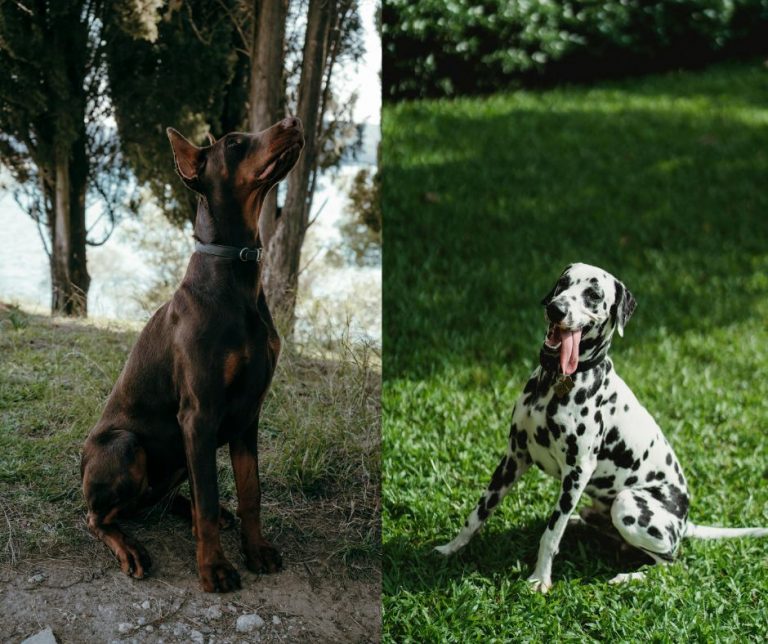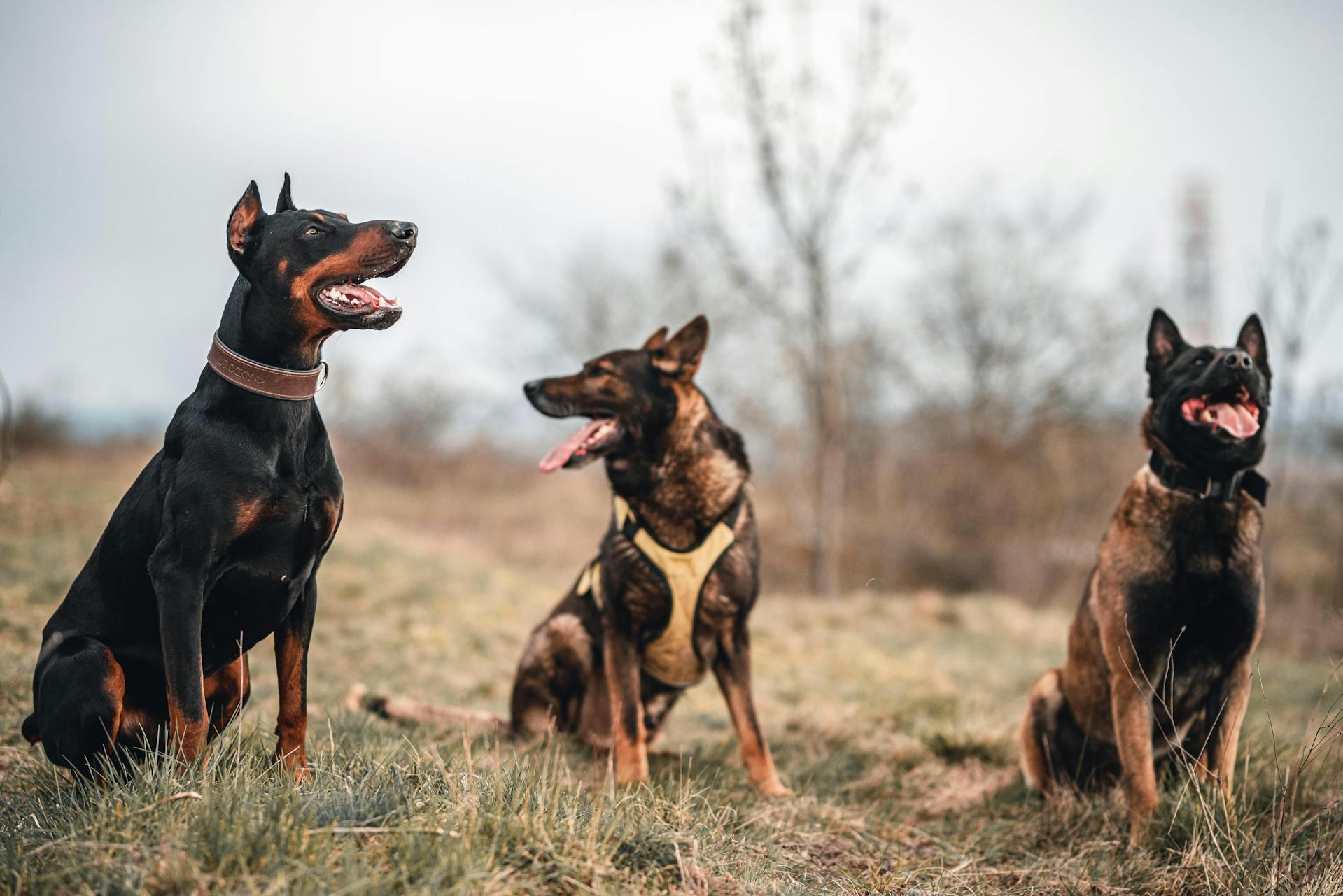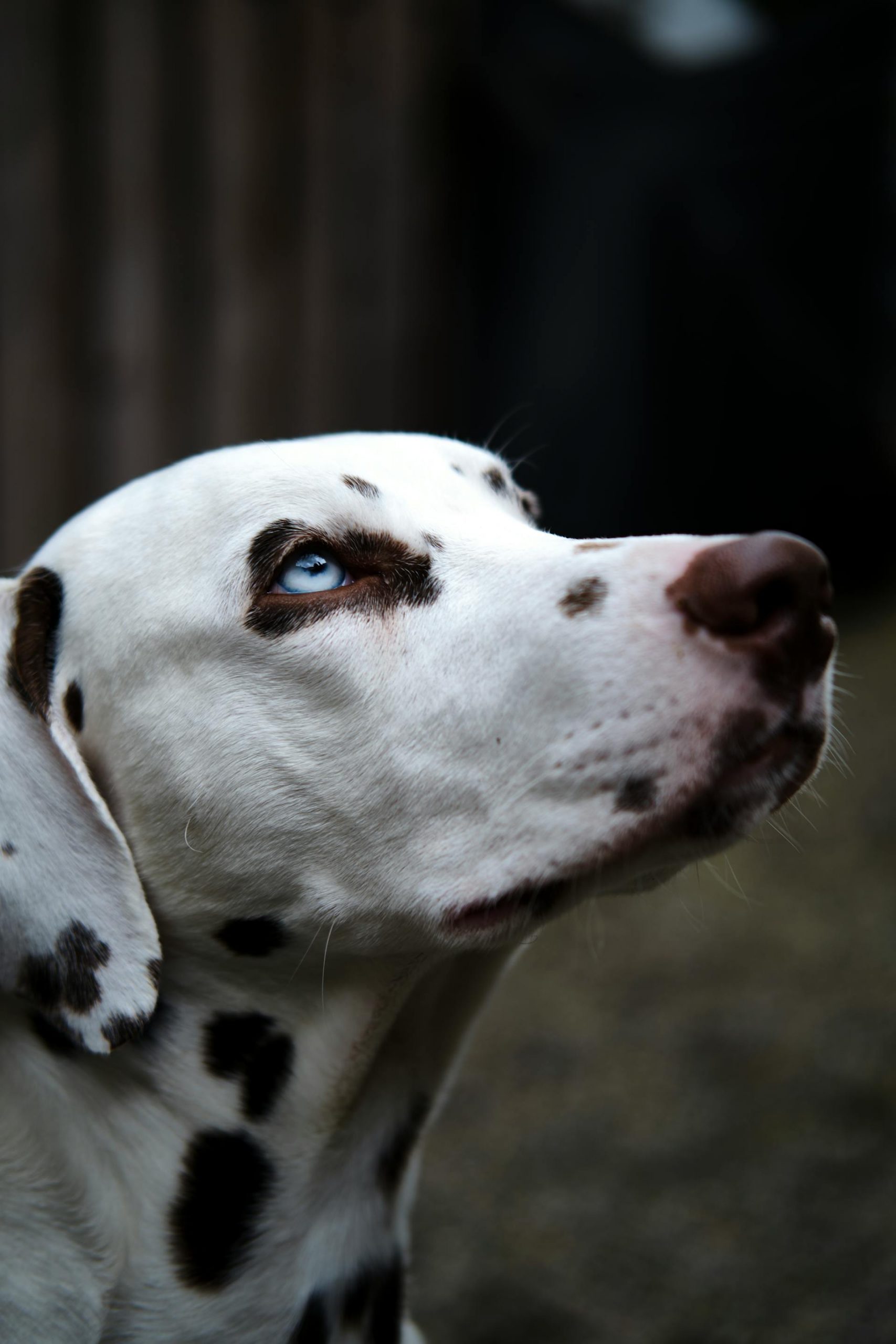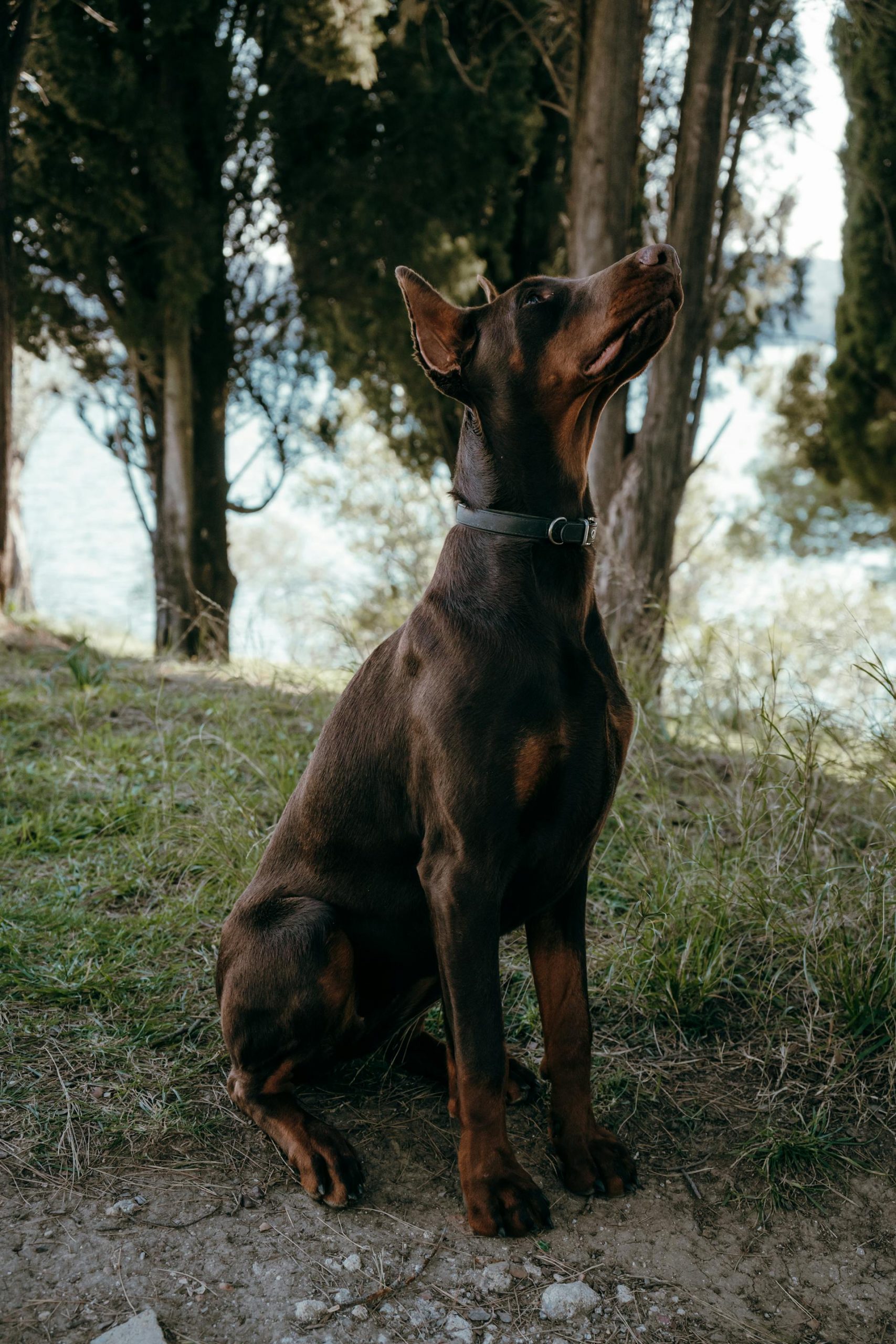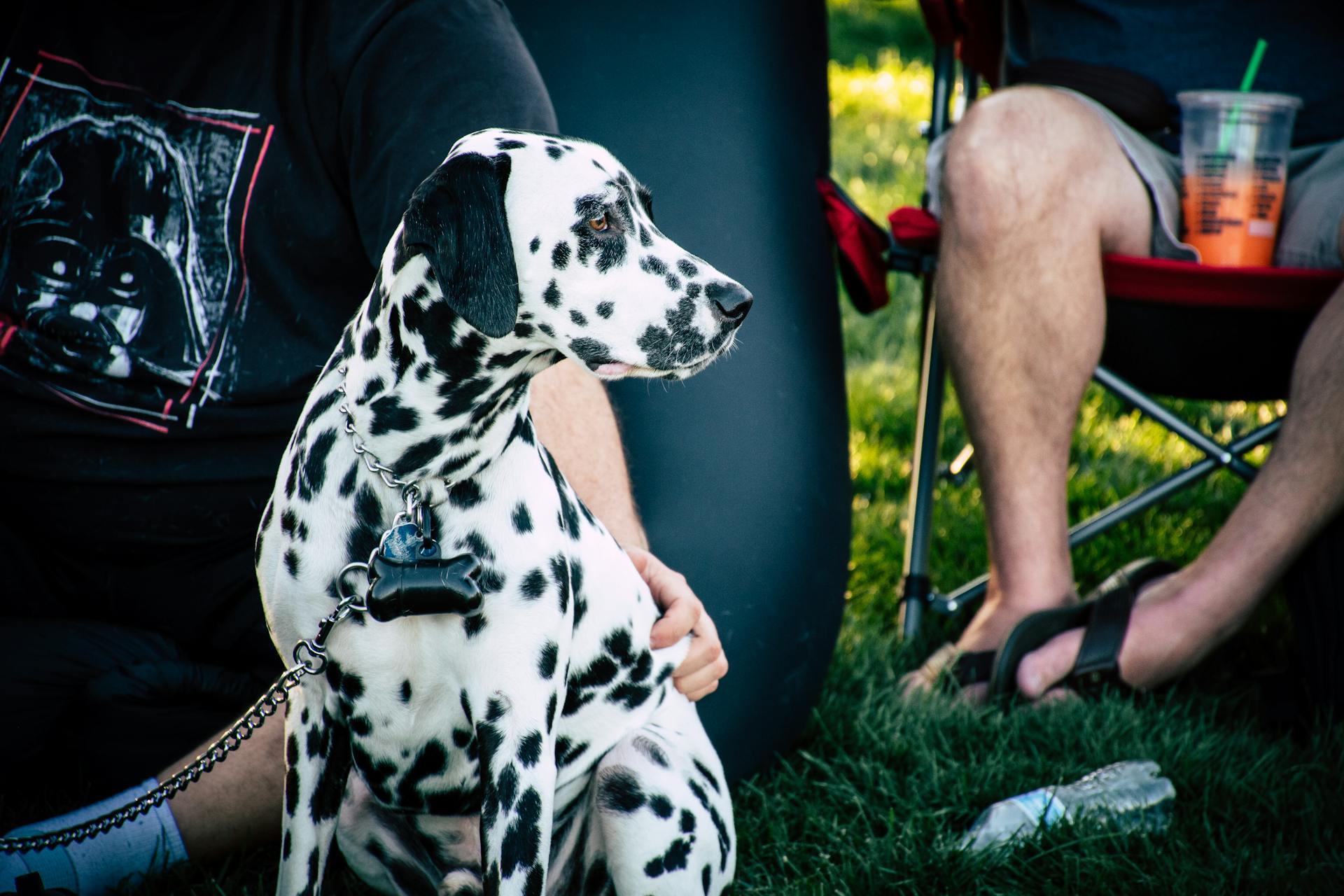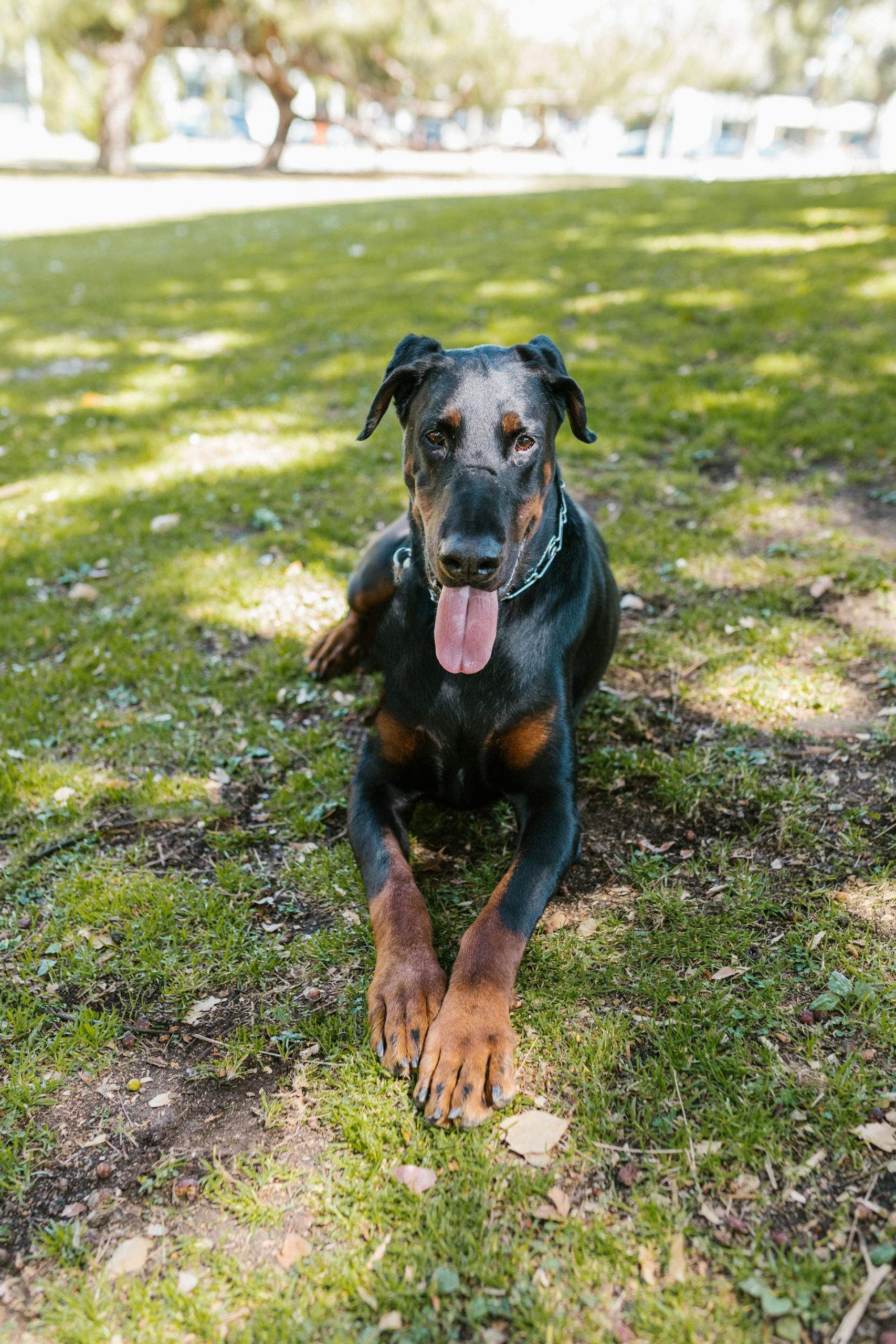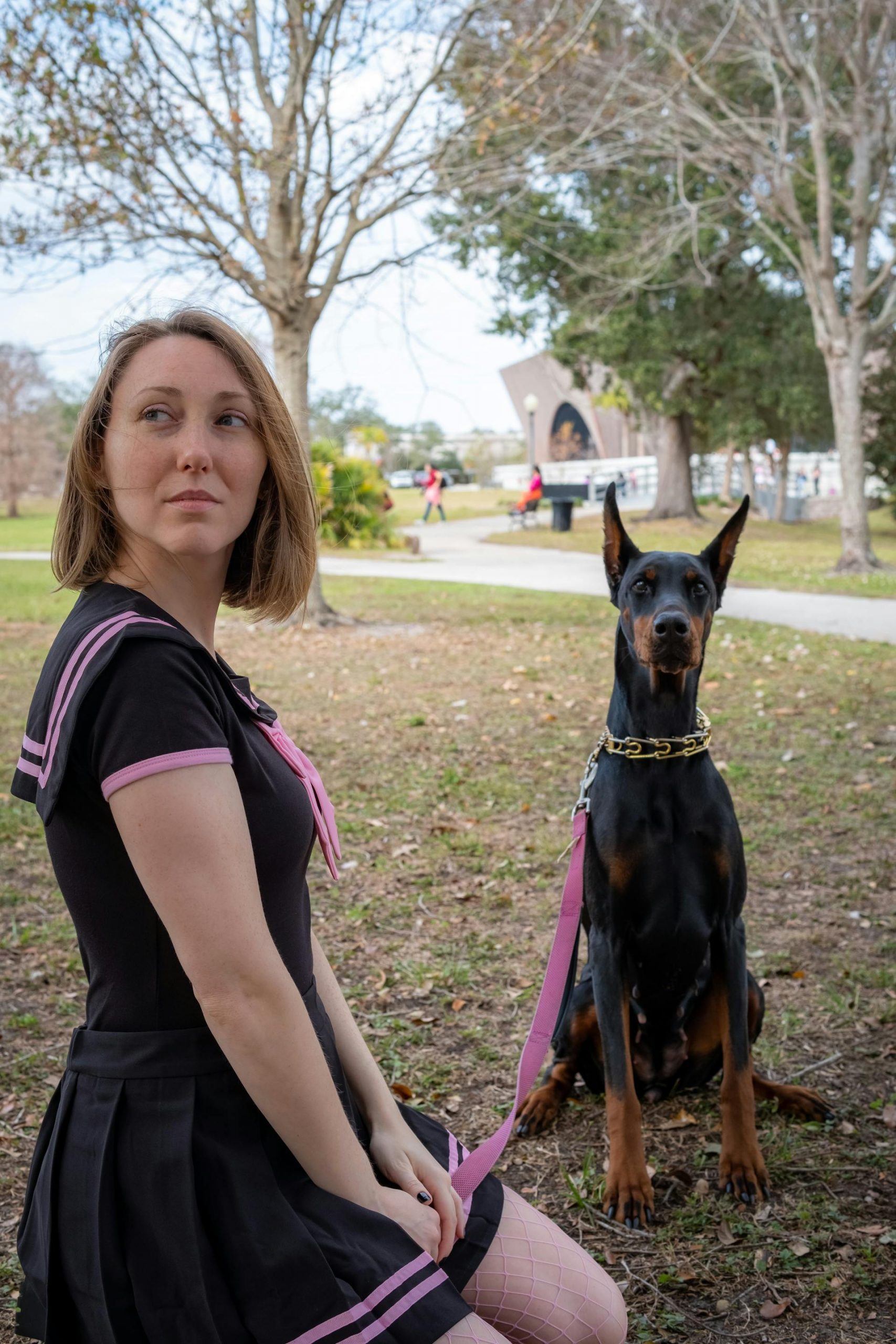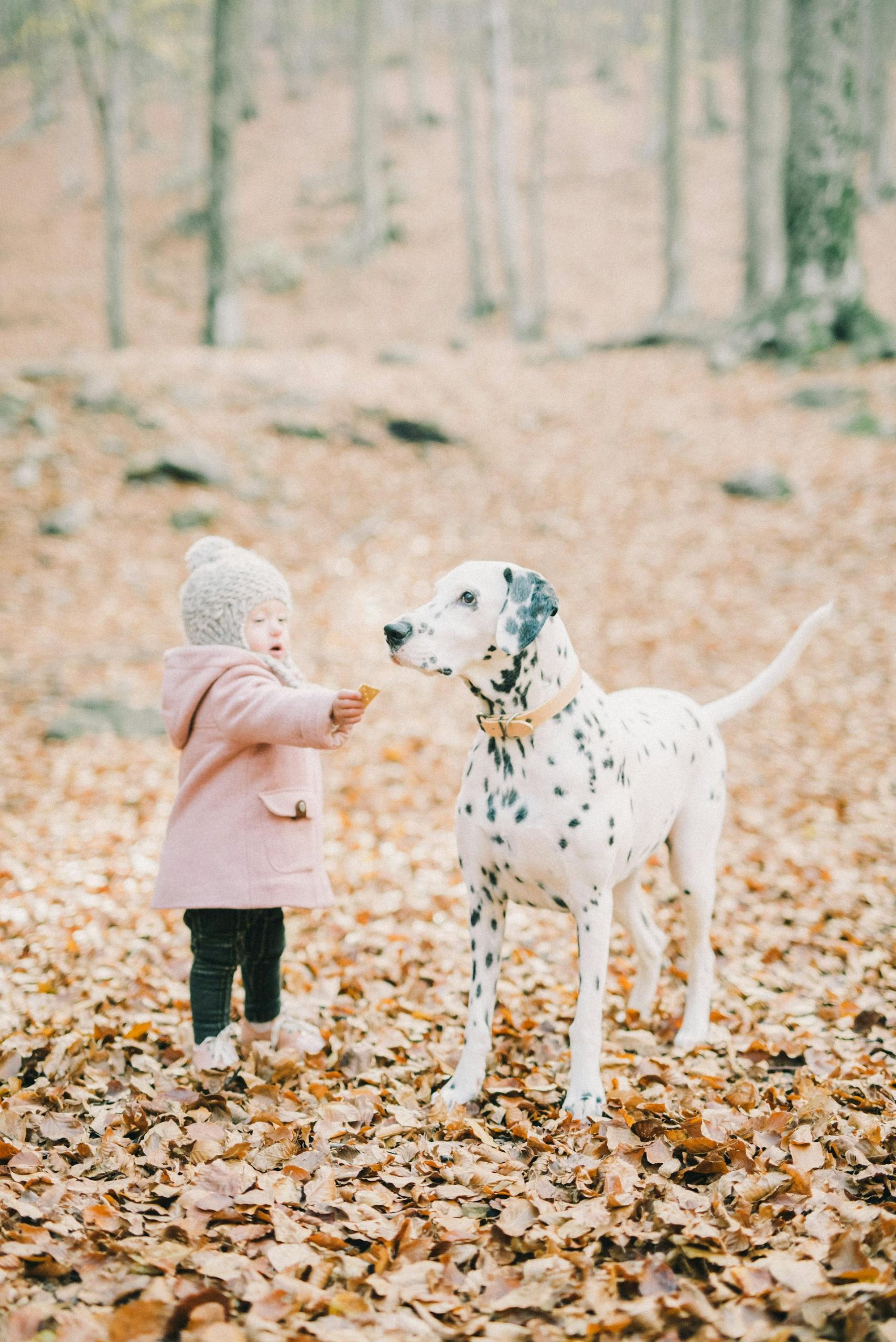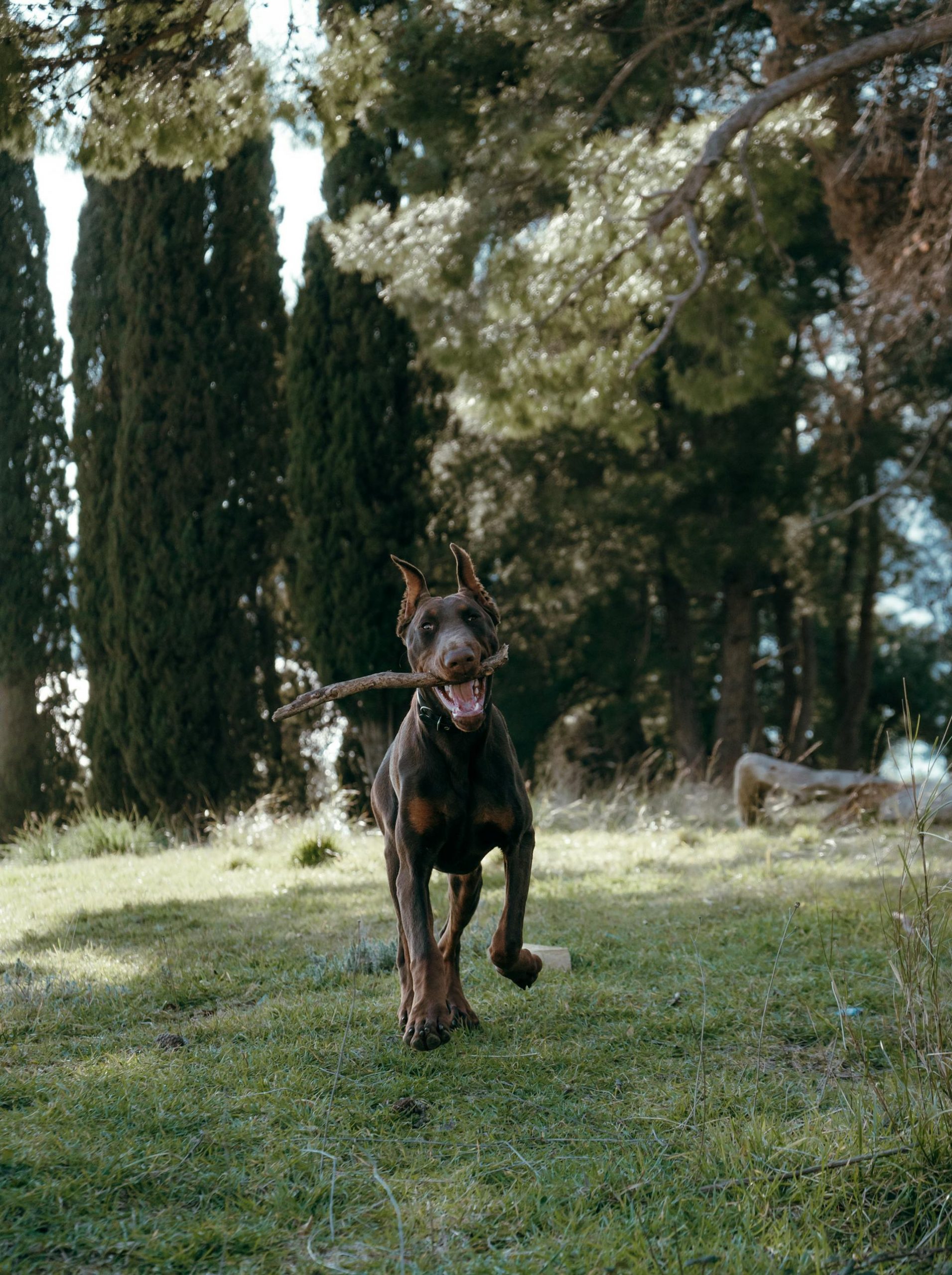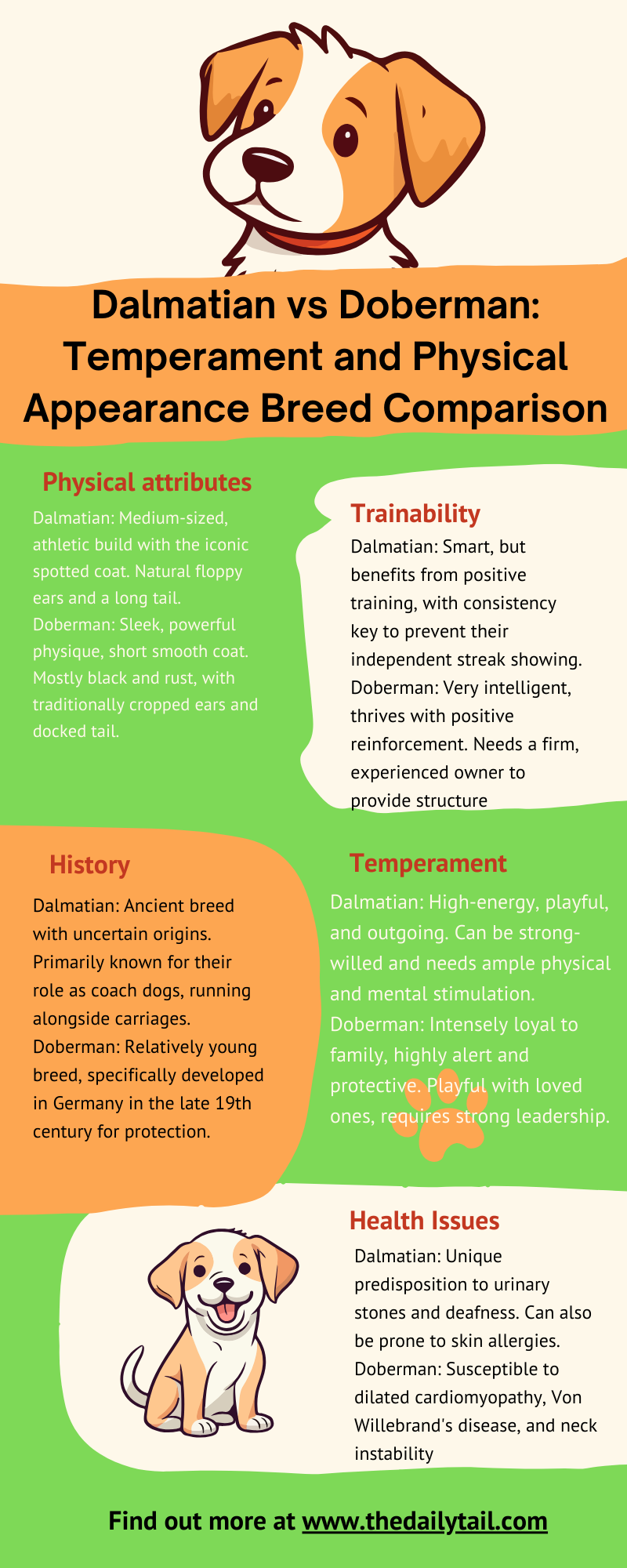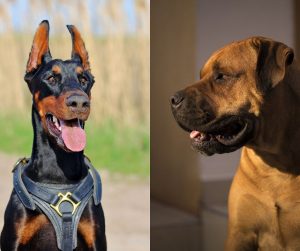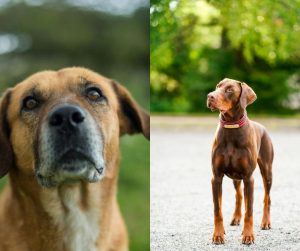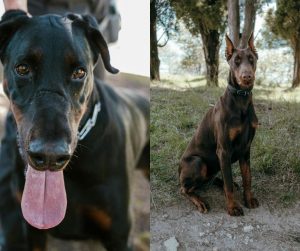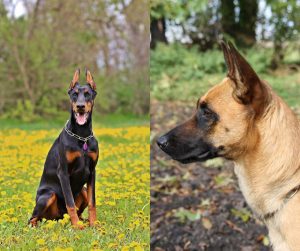It’s a battle of boundless energy vs. focused intensity, playful coach dog vs. watchful sentinel. Let’s dive into the fascinating world of the Dalmatian and the Doberman. Even someone like me who has lived with dogs for more than 30 years, cannot easily make this decision. Let me help you get all the facts right, so you can try and make one for you.
Choosing between a Dalmatian and a Doberman Pinscher isn’t just a matter of selecting a breed with spots or sleek dark fur; it’s about finding a furry companion that fits your lifestyle.
Dalmatians, recognizable for their unique spotted coats and historical role as carriage dogs, bring an energetic yet loyal disposition to a household. Meanwhile, Dobermans boast an impressive stance, reflecting their past as protectors and guardians.
Both these breeds might share a strong, athletic build, yet they carve out distinct places in the hearts of their owners with their varying needs and personalities.
Understanding these breeds goes beyond aesthetics, as each requires different levels of exercise, training, and care. Potential health concerns and compatibility with living environments must also be considered when choosing between a spotty companion and a muscular guardian.
Each breed sports its own narrative, stemming from their origins and historical purpose, culminating in a rich tapestry that defines their behavior and care needs. Matching with the right dog means considering these traits and how well they align with your daily routine and long-term plans. With that in mind, let’s take a look at the Dalmatian vs Doberman dog breed comparison.
Key Takeaways
- Dalmatians and Dobermans differ significantly in terms of history, temperament, and exercise needs
- Health considerations and compatibility with living environments must be factored into the decision
- Choosing the right breed involves matching a dog’s traits with an pet parent’s lifestyle and preferences
Breed Origins and History
When comparing the Dalmatian and Doberman Pinscher, understanding their unique origins and the shaping of their histories provides insight into how these breeds have become the beloved companions they are today. Both stemmed from distinct European regions and were bred with specific functions in mind.
Dalmatian Origins
The Dalmatian has a coat that’s hard to miss, with its distinctive spots making it an easily recognizable breed. Historically, these dogs have roots trailing back to Croatia, particularly the region known as Dalmatia.
Though their complete history isn’t crystal clear, it’s generally agreed that they began to appear around the mid-1800s. The American Kennel Club (AKC) has acknowledged their varied roles throughout history, from coaching dogs trotting alongside carriages, to working as circus performers due to their high intelligence and trainable nature.
Doberman Evolution
On the other hand, the Doberman stems from a more recent lineage. They hail from Germany, with the credit for their development going to tax collector Louis Dobermann.
His aim was to create a vigilant but loyal protector to accompany him. The town of Apolda in the late 19th century is often cited as the birthplace of the Doberman breed, which the AKC officially recognized in 1900.
Initially bred for protection, the Doberman’s role has evolved over time, showing their versatility as both working dogs and family companions.
Physical Characteristics
When choosing between a Dalmatian vs Doberman Pinscher, it’s helpful to understand how they differ in their looks. After all, these breeds not only have unique personalities but their physical traits set them apart too.
Size and Weight
Dalmatians are medium-sized dogs renowned for their distinctive spotted coat. They typically weigh between 45 to 70 pounds, and their height ranges from 19 to 24 inches at the shoulder.
In contrast, Doberman Pinschers lean towards the larger side with a muscular build. They usually tip the scales at about 60 to 100 pounds. As for height, they stand taller than Dalmatians, with an average of 24 to 28 inches at the shoulder.
Coat and Appearance
The coat of a Dalmatian is short, sleek, and glossy. It comes predominantly in white with either black or liver brown spots spread throughout their body. Each one is unique with its spot pattern, making them quite the showstopper.
On the flip side, Doberman Pinschers boast a coat that’s also sleek but denser, and they exhibit a more defined palette of colors. These canines come in black, red, blue, or fawn often accented with rust markings. Known for their elegant appearance, Dobermans hold a proud stance and regal expression.
Personality Traits
When choosing between a Dalmatian puppy and a Doberman Pinscher puppy, understanding their distinct personality traits is crucial. Each breed exhibits a unique blend of characteristics that make them suitable for different family dynamics and lifestyles.
Dalmatian Temperament
Dalmatians are renowned for their energetic and playful nature. They are often described as affectionate and friendly dogs, making them excellent companions for families. Here’s what you should know about a Dalmatian’s temperament:
- Energetic: Full of vigor, they require regular exercise to maintain their happiness
- Playful: They love interactive games and activities with their humans
- Intelligent: Highly trainable, Dalmatians grasp commands and tricks quickly
- Sensitive: Dalmatians can be quite sensitive to their environment and may react to sudden changes
- Outgoing: They tend to be social butterflies, enjoying the company of people and other dogs
Doberman Disposition
Dobermans, on the other hand, are recognized for being intelligent, loyal, and protective, which makes them exceptional watchdogs. Here are some specifics regarding Doberman’s personality:
- Alert: Dobermans are always on guard, ready to protect their home
- Obedient: With proper training, they are known for their willingness to follow commands
- Fearless: This breed does not shy away from a challenge and stands strong in the face of adversity
- Affectionate: They form strong bonds with their family members, often becoming loyal companions
- Smart: Dobermans are clever and excel in various canine sports and obedience training
Health and Wellness
When looking at the Dalmatian and Doberman dog breeds, one can see they have distinct health issues and care needs. Understanding these can help prospective owners provide the best quality of life for these dogs.
Common Health Issues
Dalmatian dogs are prone to certain genetic diseases such as deafness which can affect their quality of life. They also can suffer from skin allergies and urolithiasis—the formation of urinary stones. Hip dysplasia, a joint problem, can also be a concern for these spotted friends.
On the other hand, Dobermans face risks of cardiomyopathy, a serious heart condition, and hip dysplasia. They may also develop progressive retinal atrophy (PRA), which can lead to blindness, and Wobbler’s Syndrome, a condition affecting the neck’s vertebrae causing an unsteady gait.
Lifespan and Care
For the average lifespan, Dobermans typically live between 10 to 13 years. In contrast, Dalmatians have a slightly longer span, living on average from 11 to 13 years.
Regular veterinary visits are essential to monitor their health closely and manage any condition that may arise.
As far as care goes, both breeds require a balanced diet and adequate exercise needs.
Dobermans are muscular and athletic, necessitating plenty of activities to channel their energy positively. Dalmatians are equally energetic and benefit from regular physical activities to help maintain their health and prevent issues like obesity, which can exacerbate hip dysplasia.
Regular check-ups and a proactive approach to health can mitigate many of the potential issues, ensuring both breeds live a full and comfortable life.
Training and Exercise
Dog training and exercise are cornerstones of a happy and healthy life for both Dalmatians and Dobermans. Both breeds are known for their high energy levels and intelligence, which translates into a need for both physical and mental stimulation.
Training Requirements
Dalmatian:
- Trainability: High; they are smart and generally easy to train but require consistent, positive reinforcement
- Service and Therapy: Often used as service dogs due to their high intelligence and trainability
- Guarding/Hunting: Less inclined for guarding; originally bred as coach dogs, running alongside carriages
Doberman:
- Trainability: Very high; known for their outstanding ability to learn and follow commands with ease
- Service and Guarding: Excellent guard dogs with a natural instinct to protect; also suitable for various service roles due to their trainability and smart nature
Remember: Despite their smartness, early socialization and obedience training are crucial for both breeds to help them develop into well-behaved adults.
Exercise Demands
Dalmatian:
- Energy Level: High; they require regular, vigorous exercise to keep them physically and mentally satisfied
- Exercise Types: Enjoy a variety of activities such as running, playing fetch, and participating in canine sports like agility
Doberman:
- Energy Level: Very high; these active dogs need plenty of exercise — skipping it is not an option
- Exercise Types: Benefit from engaging in structured exercises like obedience training, tracking, and activities that challenge them both physically and mentally
Both breeds do best with owners who lead active lifestyles and can give them the time and attention they need. While grooming is generally easier for both, due to their short coats, this is a secondary consideration when compared to their substantial dog training and exercise needs.
Living Environment
When choosing between a Dalmatian dog and a Doberman puppy, it’s essential to consider how well each breed adapts to home life and what their presence may mean for a family setting. Each dog has unique requirements and characteristics that influence their compatibility with various living environments.
Adapting to Home Life
The Dalmatian breed has a storied history as carriage dogs. They’re used to an active lifestyle and thrive in environments that provide ample space to move and burn off energy.
Despite this need for physical activity, a Dalmatian can adapt to apartment living as long as they’re given regular exercise and mental stimulation.
In contrast, Dobermans are versatile and can adjust to changes, including different living environments. They do especially well when they have a yard to patrol, but with enough exercise, they too can be suitable for an apartment.
- Dalmatian: Needs regular exercise; a yard is ideal but can adapt to apartments with active owners
- Doberman: Highly adaptable; does well in both houses and apartments if exercise needs are met
Suitability for Families
Families often look for pets that are not only loving but also patient with children. Dalmatians tend to be very pet friendly and make great companions for kids, provided they have been socialized properly from a young age.
Their playful and energetic nature makes them a wonderful addition to active households. However, they may be too exuberant for very small children without proper training and supervision.
Dobermans, on the other hand, are known for their loyalty and can be dog-friendly when raised alongside other pets. They’re protective, making them diligent when it comes to family safety.
With a solid upbringing, Dobermans can be gentle and affectionate with families and are known to be particularly good for novice owners who are willing to invest time in training and socialization. Both these medium size dog breeds will fit wonderfully into your household.
- Dalmatian:
- Excellent with children and other pets
- Requires socialization and training to ensure safety around small children
- Doberman:
- Protective yet affectionate with family
- Suitable for novice owners willing to dedicate time to their training
Breed Popularity and Availability
When choosing between a Dalmatian and a Doberman, it’s intriguing to examine how common these breeds are and what it takes to bring one home. They’re both adored for distinct qualities, but their presence in homes and the ease of finding a purebred can sway potential owners.
Popularity Rankings
The Dalmatian and the Doberman Pinscher have fluctuated in popularity over the years, often influenced by media portrayals and breed trends.
Historically, Dalmatians gained widespread recognition for their spotted coat and association with firefighting, while the Doberman’s commanding presence cemented their status as effective working dogs.
In terms of popularity rank, the American Kennel Club currently lists the Doberman Pinscher as the 17th most popular breed in the United States, reflecting their reputation as loyal and vigilant companions. Dalmatians hold a spot as the 51st most popular breed, illustrating a devoted albeit smaller following.
Finding a Purebred
For those looking to add a Dalmatian or Doberman to their family, seeking a purebred dog can be a journey of its own.
Purebred puppies from reputable breeders ensure that you’re getting a dog with predictable traits and health clearances. Potential owners should expect an average wait time, as reputable breeders may not have puppies available immediately, emphasizing the importance of planning and patience.
Dobermans, being a tad more popular, might be slightly easier to find through breed-specific rescues or adoption networks. They often look for loving homes that understand the needs of these intelligent, energetic working dogs.
On the other hand, Dalmatians, as companion dogs with unique care requirements, can also be found through dedicated rescue groups that may occasionally have dogs needing adoption.
Care Considerations
When it comes to caring for Dalmatians and Dobermans, pet parents should be mindful of each breed’s unique needs. From their glossy coats to their dietary preferences, understanding these requirements will ensure these dogs lead happy, healthy lives.
Grooming Needs
Dalmatians are known for their distinctive white coats peppered with black or liver brown spots. They have short hair that sheds year-round, so regular brushing, about two to three times a week, can help manage this shedding. An occasional bath keeps their coat shiny and clean.
On the other hand, Dobermans also sport a short coat, but they tend to shed less than Dalmatians. A weekly brush is usually sufficient to keep their coat in good condition. Both breeds will benefit from the usual grooming rituals of nail trimming, ear cleaning, and dental care to prevent common health issues.
Diet and Nutrition
When it comes to diet, both breeds thrive on high-quality dog food that’s suited to their age, weight, and exercise needs.
Dalmatians have a unique urinary system that can form stones, so foods low in purines can help mitigate this risk. They typically weigh between 45-70 pounds, so their food intake should be adjusted accordingly to prevent obesity. It’s also essential to provide them with plenty of freshwater to support their urinary health.
Dobermans are larger, muscular dogs, often weighing between 60-100 pounds, depending on gender and age, and require a well-balanced diet to maintain their lean physique. While not as prone to urinary issues as Dalmatians, they do have their potential health problems, such as heart conditions and joint issues, so keeping them at a healthy weight is critical. Since Dobermans can sometimes gulp their food too quickly, which might lead to bloating, it’s a good idea to use a slow-feeder bowl and split their meals into two times per day.

